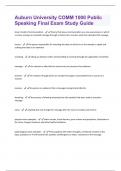Auburn University COMM 1000 Public Speaking Final Exam Study Guide linear model of communication - theory that views communication as a one -way process in which a source conveys an encoded message through a channel to a receiver, who then decodes that message source - the person responsible for inventing the idea on which he or she intends to speak and crafting that idea to an audience encoding - taking an abstract notion and providing it meaning through the application of symbols message - the content or idea that the source tries to convey to the audience channel - the medium through which an encoded message is transmitted from a source to a receiver receiver - the person or audience that a message is being transmitted to decoding - the process of drawing meaning from the symbols that were used to encode a message noise - anything that can change the message after the source encodes and sends it physical noise examples - other sounds, visual barriers, poor volume and projection, distraction in the room, hunger, tiredness, and other bodily limitations psychological noise examples - Preoccupation with other thoughts, emotional reaction to the topic, prejudice or ill will towards the speaker, unwillingness to listen, resistance to the message. interactive model of communication - communication theory that views communication as a two -
way process that includes feedback and the environment feedback - the receiver's response to a message that is sent to the sender environment - the context in which the communication process takes place environmental elements - beliefs, context, history, participants, relationships, physical setting, values transactional model of communication - the theory that views communication as a constant process in which all parties simultaneously play the roles of sender and receiver similarities in conversation and speech - Audience -centered, attention to feedback, goal -driven, logic is required, stories for effect. differences in conversation and speech - language choices, speeches require more organization, use of notes, no interruptions, delivery style, physical arrangement 3 public speaking myths - Public speaking is a talent not a skill, speech is easy we do it all the time, there is no right way to deliver a speech phobia - a persistent, irrational fear of a specific object, activity, or situation that leads to a compelling desire to avoid communication apprehension - the fear or anxiety associated with real or anticipated communication with another or others self-fulfilling prophecy - convincing yourself that something is going to happen before it does, thus leading to the occurrence of what you originally expected physical effects of communication apprehension - Rise in blood pressure/face flushing red, shortness of breath, galvanic skin tightening, perspiration. systematic desensitization - the process whereby a person is slowly introduced to a fear such that each time he or she overcomes the fear the intensity is decreased ethics - involve morals and the specific moral choices to be made by a person ethics of choosing a topic - speakers must choose topics and messages they firmly believe are in the best interests of their audience Plagiarism - taking the intellectual achievements of another person and presenting them as one's own global plagiarism - taking an entire piece of work and saying that it is your own incremental plagiarism - using part of someone else's work and not citing it as a source patchwork plagiarism - taking ideas from more than one piece of work and putting them together into a new piece of work, and then presenting them as original work without giving due credit to the sources patchworking - taking original source material and changing a few words in it, but not enough to consider it a paraphrase, all the while not citing the original source material ethics of language and delivery - Maintain composure, describe people with respect, avoid profanity, balance simplicity and complexity, balance emotion and logic. rules for civility - pay attention, speak kindly, don't speak ill of others, assert yourself, don't shift responsibility and blame, respect others' opinions, listen, mind your body, respect other people's time, acknowledge others




